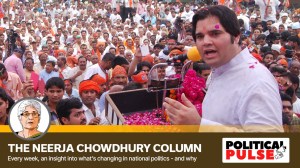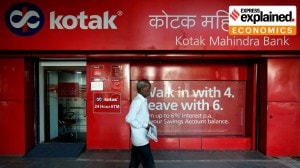- India
- International
PM Modi meets Donald Trump: Trade, energy, terrorism — what unfolded during the White House talks
PM Narendra Modi and Donald Trump met for about four hours at the White House. We take a look at what the two leaders discussed and what it means for the region. Trade, terrorism and energy were the key issues discussed during the bilateral meeting.
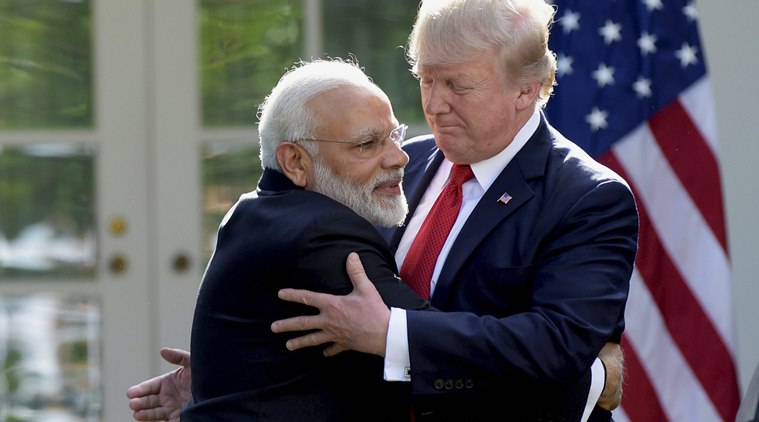 Prime Minister Narendra Modi and President Donald Trump hug while making statements in the Rose Garden of the White House in Washington, Monday. Associated Press
Prime Minister Narendra Modi and President Donald Trump hug while making statements in the Rose Garden of the White House in Washington, Monday. Associated Press
“A true friend” — that’s how President Donald Trump described India as he welcomed Prime Minister Narendra Modi to the White House, Monday evening. The two leaders spent a little over four hours — including Trump’s first working dinner with a Head of State — discussing a wide range of issues including trade and terrorism. Following their one-on-one meeting, the two leaders issued a joint press statement at the Rose Garden but, as decided earlier, did not take any questions from the media.
Here’s a quick look at what unfolded at the meeting between the two ‘social media leaders’ Modi-Trump:
How long did Trump and Modi meet for?
The two leaders spent a little less than five hours together — discussing a range of issues. The meeting began with a 20-minute one-on-one meeting between the two leaders followed by delegation-level talks between officials of the two nations. Modi and Trump then issued a joint statement at the Rose Garden. Following this, the two delegations took a 30-minute cocktail break — hosted by Vice President Mike Pence. They then once again sat down for a ‘working dinner’ — a first for the Trump administration — that lasted about an hour. The Indian delegation then left for their hotel.
What did the two leaders discuss during their meeting?
Trade and terrorism were the two key talking points of the meeting. But there was much more. In the joint statement issued, the two nations also discussed strengthening energy strategies. While there was no explicit mention of the Paris climate deal, the leaders called for a rational approach that balances environment and climate policy, global economic development, and energy security needs. A key issue for India that was not mentioned in the joint statement was that of H1-B visas. It wasn’t immediately known if the issue came up for discussion between Trump and Modi, or not.
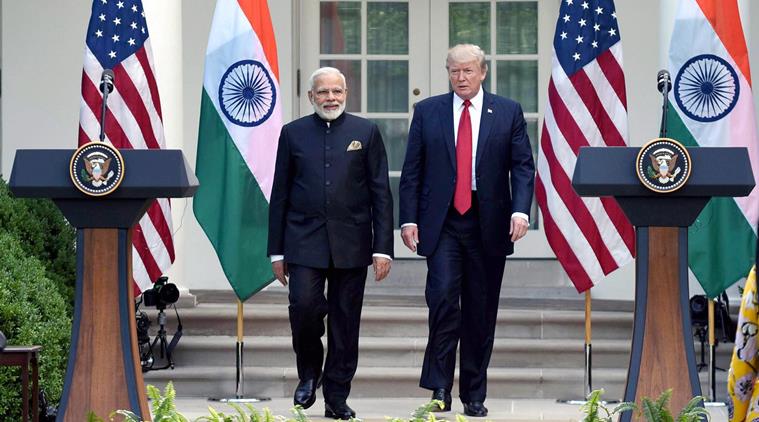 Modi Trump meet: Prime Minister Modi and President Donald Trump arriving to deliver the Joint Press Statement, at White House, in Washington. PTI
Modi Trump meet: Prime Minister Modi and President Donald Trump arriving to deliver the Joint Press Statement, at White House, in Washington. PTI
On terrorism, the two nations reiterated their demand that Pakistan ensure its territory is not used to shield terrorists and launch terror attacks in the region. “Both our nations have been struck by the evils of terrorism, and we are both determined to destroy terrorist organisations and the radical ideology that drives them. We will destroy radical Islamic terrorism,” Trump said in his statement to the press. Modi, on his part, reiterated India’s concern regarding terrorism in the Indo-Pacific region. “Fighting terrorism and doing away with the safe shelters, sanctuaries, and safe havens will be an important part of our cooperation,” Modi said. The two nations, in the joint statement, also specifically mentioned instances of cross-border terrorism, calling on Pakistan to bring to justice “the perpetrators of the 26/11 Mumbai, Pathankot, and other cross-border terrorist attacks perpetrated by Pakistan-based groups.” You can read more, here.

On trade, Trump said he would like it to be ‘fair and reciprocal’, hoping that the trade deficit with India currently almost $31 billion will fall. “It is important that barriers be removed to the export of US goods into your markets, and that we reduce our trade deficit with your country,” Trump said. Trump also welcomed India’s Spicejet airlines order of about 205 aircraft from Boeing, worth up to $22 billion that the airliner co-founder Ajay Singh says will ensure up to 132,000 American jobs. The leaders were also hopeful that tax reforms launched by both the countries will “unlock immense economic opportunities”. Modi said India would continue to strengthen the already existing trade and manufacturing partnership the two nations share, something, Modi said, that was beneficial to both the nations.
Okay, what about the Indo-US nuclear deal?
The deal between India’s Nuclear Power Corporation of India (NPCI) and Westinghouse Electric Company featured in the talks between the two nations. Trump and Modi were hopeful that the deal for six nuclear reactors and the projects financing would soon be completed. India and US also announced that they would boost energy ties and expand innovation linkages across the sector while deepening cooperation on efficient fossil fuel technologies, smart grids and energy storage. Financing of energy projects — including clean coal — by Multilateral Development Banks was also discussed between the two delegations.
Did China come up in talks?
Not directly. The two leaders spoke of being responsible stewards in the Indo-Pacific region and agreed that a close partnership between them is central to peace and stability. In a veiled reference to China’s Belt and Road Initiative, that India has refused to be a part of, the statement mentions that the two leaders support “bolstering regional economic connectivity through the transparent development of infrastructure and the use of responsible debt financing practices, while ensuring respect for sovereignty and territorial integrity, the rule of law, and the environment; and call on other nations in the region to adhere to these principles.”
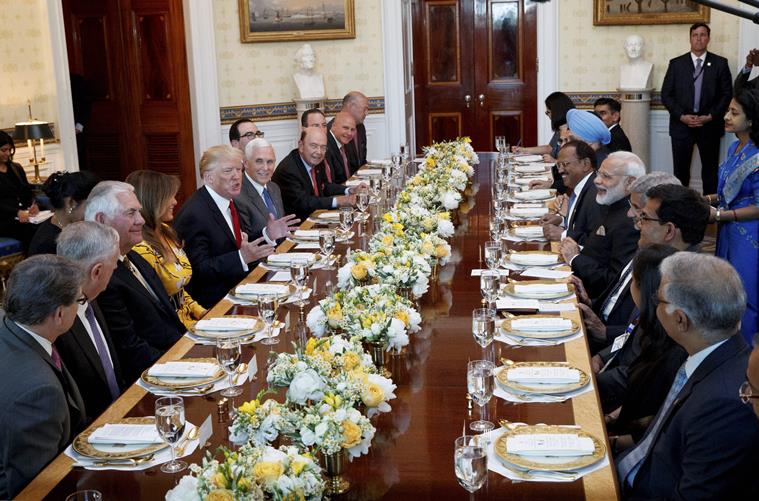 Modi Trump meet: President Donald Trump speaks during a dinner with Prime Minister Narendra Modi at the White House. This is the first working dinner hosted by the Trump administration. Associated Press
Modi Trump meet: President Donald Trump speaks during a dinner with Prime Minister Narendra Modi at the White House. This is the first working dinner hosted by the Trump administration. Associated Press
Interestingly, when India announced it was not going to attend the BRI Summit, MEA Spokesperson Gopal Baglay had said the following: “Connectivity initiatives must follow principles of financial responsibility to avoid projects that would create unsustainable debt burden for communities; balanced ecological and environmental protection and preservation standards; transparent assessment of project costs; and skill and technology transfer to help long term running and maintenance of the assets created by local communities. Connectivity projects must be pursued in a manner that respects sovereignty and territorial integrity.”
The two leaders resolved to “increase cooperation, enhance diplomatic consultations, and increase tangible collaboration with partners in the Middle East”.
Modi and Trump also expressed concern regarding North Korea’s repeated continued provocations, emphasising that its “destabilising pursuit of nuclear and ballistic missile programs poses a grave threat to regional security and global peace”, and pledged to work together to counter the DPRK’s weapons of mass destruction programs, “including by holding accountable all parties that support these programs” — again a veiled mention of China.
So what’s the significance of the meeting?
India, for one, wanted to revitalise its relationship back to what it was like under the Obama administration. This, after the Trump administration appeared to have courted China to have them act against US rival North Korea.
Trump’s statements on ‘territorial integrity’ and his administration’s outright condemnation of terrorism by Pakistan-backed organisations was something India was hopeful would come out of the meeting. Moreover, the United States also designated the Hizb-ul-Mujahideen leader Sayeed Salahudeen as a specially designated global terrorist, in what appears to be a big win for India in its fight against terrorism.
The two leaders also affirmed their support for the UN Comprehensive Convention on International Terrorism, something the Obama administration was reluctant to endorse, according to Joshua White, a former White House and Pentagon official. White adds that the “new consultation mechanism” on terrorist listings would be beneficial to both nations and was overdue.
The US also reiterated its strong support for India’s early membership in the Nuclear Suppliers Group, the Wassenaar Arrangement, and the Australia Group. Trump also welcomed India’s formal entry into the International Expedited Traveler Initiative (Global Entry program) that facilitates closer business and educational ties between the citizens of India and the US.
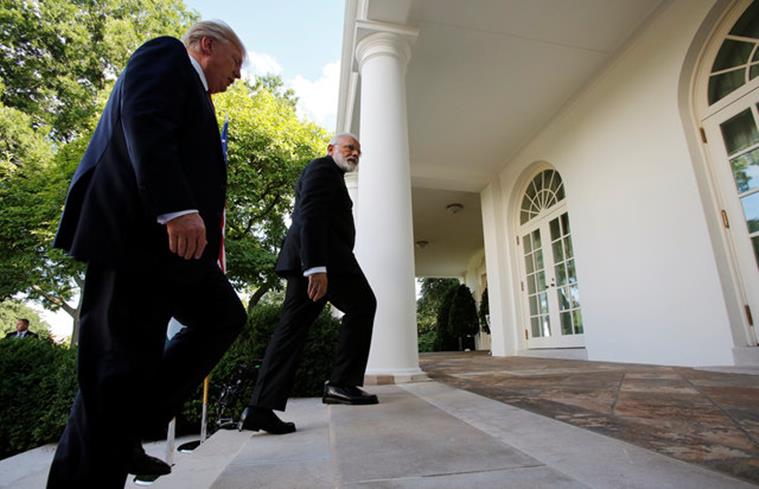 Modi Trump meet: President Donald Trump and Prime Minister Modi head back to the Oval Office after delivering joint statements in the Rose Garden of the White House in Washington. Reuters
Modi Trump meet: President Donald Trump and Prime Minister Modi head back to the Oval Office after delivering joint statements in the Rose Garden of the White House in Washington. Reuters
The joint statement (which you can read here), however, stops short of mentioning a key issue that India has been discussing – that of employment in the US and the issuing of H1B visas.
On climate change, the statement on energy makes a mention of ‘clean coal’ but says nothing about the Paris climate deal. Trump, while pulling out of the accord, had then mentioned India as having received millions of dollars in aid. “India makes its participation contingent on receiving billions and billions and billions of dollars in foreign aid from developed countries,” he had then said.
Indicating that both the leaders hope to do much work in boosting their respective economies through mutual partnerships, Modi said: “I am sure that the convergence of my vision for ‘New India’ and President Trump’s vision for making America great again will add new dimensions to our cooperation.”
Apr 24: Latest News
- 01
- 02
- 03
- 04
- 05







